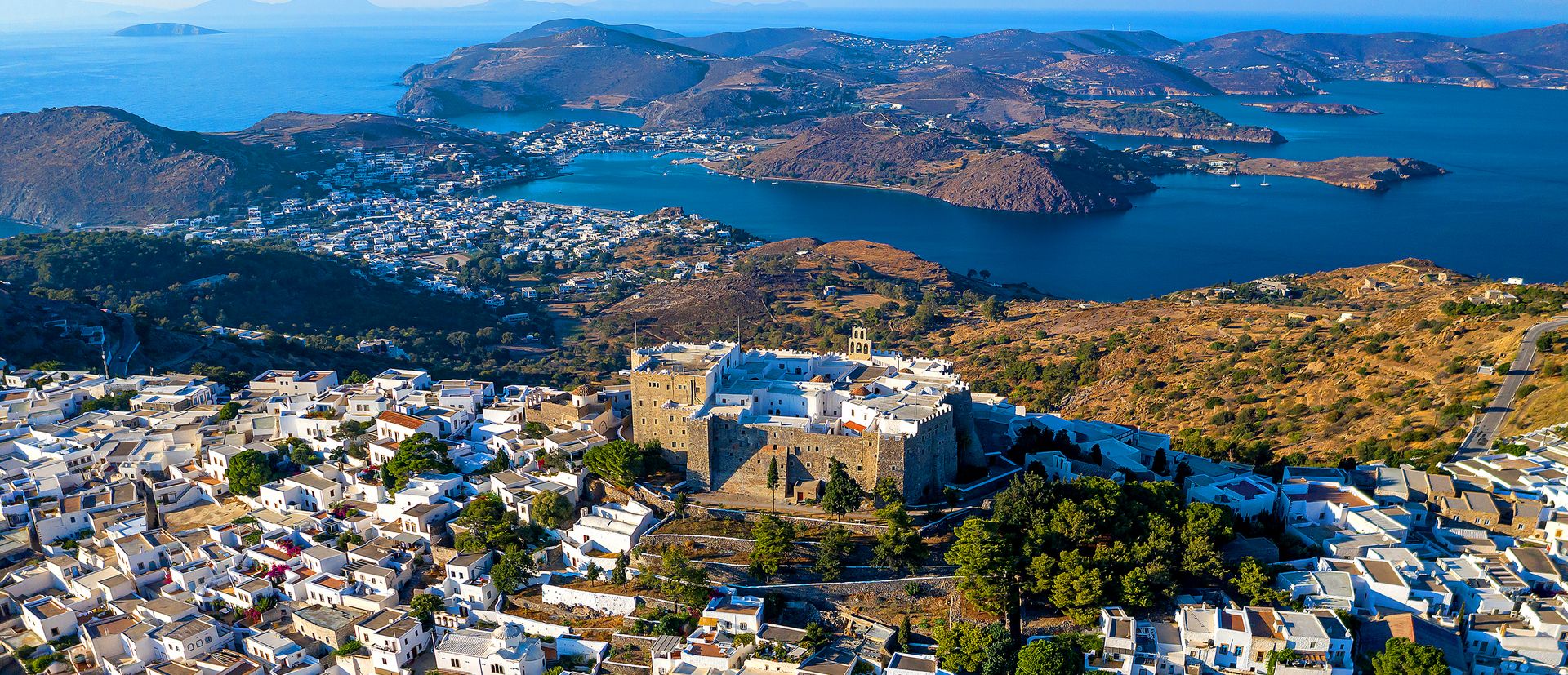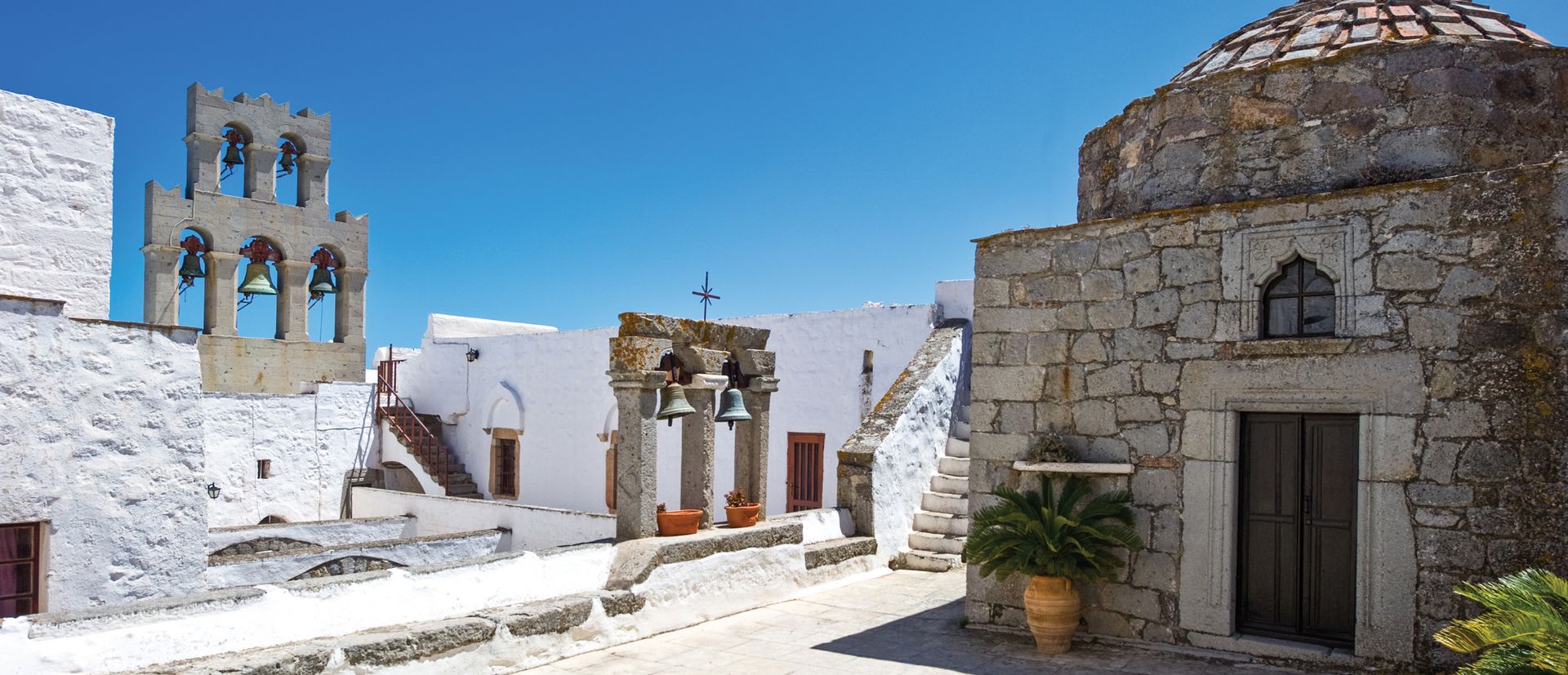The noble island of Patmos is famous for its religious heritage. It is known as the island of the Apocalypse as well as for its cosmopolitan style, as it is an elegant mosaic of the traditional Aegean architecture, Byzantine tradition and the authentic Greek era. In Patmos you will make a trip of recreation and inner peace. From the very first moment you will feel the aura and the majesty of this land.
A touch of Mythology
Patmos rested at the bottom of the sea and was visible only when Goddess Selene [Moon] would shine over it. Selene would often go to Mount Latmos to meet her beloved King Endymion, who was the son of Zeus and had the privilege of not ageing when he was asleep. Therefore he was often asleep. One night, Artemis noticed the small island glittering by the beams of Selene and fell in love with it. She decided to raise it up from the sea and make it her own. As she was unable to do it alone, she asked help from her brother Apollo but he was not willing to help and asked help from Zeus. Zeus talked to Poseidon who approved it, as he was not interested for this island.
And so, thanks to Zeus’ power, the island of Patmos emerged from the sea and revealed its beauty with the help of God Helios [Sun] who warmed the island and gave life to it. Then, Artemis convinced some of the residents from the area around Mount Latmos to go and live on this island. To honor her, the island was named by the second name of the Goddess, Litois, meaning daughter of Lito.
Visit to the Church of St. John the Theologian
The first thing visitors will notice in Patmos is the Church of St. John the Theologian which is the most important monastery of the Aegean with great history and architecture. Built at the top of the mountain, probably at the spot of the temple of Artemis, the monastery looms over the island and reminds of a byzantine palace.
Picture-perfect Hora
The Cave of the Apocalypse
In the holy cave of the Apocalypse where the shelter of St. John of Theologian was located, the last chapter of the Christian Bible was written. There, according to Christian texts God dictated to St. John the holy text. In this candlelit grotto you will feel touched as you will see the spot where the Apocalypse was written, the place where St. John was resting, the huge rock, the spot where the saint was laying his head to get some rest and a niche in the rock from his hand when he was getting up.
Next to the Cave there is the Patmian Ecclesiastical School with great history and significant graduates in Literature and Priesthood.
All this sense of reverence created by this cave is never forgotten by visitors.
Atmospheric walk to the Mills of Patmos
At the top of a hill, on the east of the Holy Church of Patmos you will find the three wind mills at the Chora that are a living monument, a bridge that links the past with present and future. The windmills, two of them dated in 1588 and one in 1863, stopped operating at the end of 1950 and were deserted. However, in 2010 French sailors undertook their fully restoration and today they have become the gem of the island.
Hiking in Patmos
Patmos has old paths that connected the settlements with the hermitages, the holy locations and rural areas. You have the opportunity to live an impressive experience, as while you cross the paths you will meet magnificent landscapes, ancient and contemporary monuments, monasteries as well as the island’s natural habitat. Don’t forget to walk to Aporthianos road, the old harbor that connects Chora with the harbor.
Koukoumavla, the small shop of wonders
A corner of positive vibes in Chora. A very special small shop that when you enter it, it seems like you are in another world, a fairy tale world. You will find many hand made products as well as books. These special items, combined with the positive vibes of the shop are absolutely linked with the positive energy of the lady owner.
Beaches
- Agriolivado: one of the most popular beaches of the island, with shallow, crystal waters. 1,5 km. away from Skala, with big sandy beach with small pebbles. Organized with umbrellas and water sports facilities.
- Kampos: maybe the most organized and busiest beach of Patmos, with various facilities. 9 km. away from Skala and ideal for water sports.
- Psili Ammos: one of the most beautiful beaches of the island. It is divided in two parts, one of them occupied by nudists. It is located on the south coast of the island and you can reach it within 20 minutes by foot or through the sea with a boat from Skala. The turquoise waters and gold sand will amaze you.
- Lampi: a beach with multicolored pebbles and crystal waters. It was named after the brightness of the sun. It is located on the northwest side of the island, 9km. away from Skala.
- Agios Theologos: small, beautiful beach at Skala’s cove. Tamarisks are found close to the sea offering shade, while shops for coffee and lunch are found at a close distance.
- Petra: famous beach with clear waters and white pebbles. Right next to it you will find the “rock of Kalikatsous” that compose a magnificent landscape.
- Geranos: famous beach wit pebbles and turquoise waters. Located on the north part of the island and quite distant from Skala.
- Vagia: very quiet, beach with pebbles with crystal clear waters and many trees that produce shade. 7 km. away from Skala and not organized.
- Grikos: 4,5 km. away from Skala, you will meet a beautiful cove with quiet waters like a lake surrounded by 2 small peninsulas.
Local products and delicacies
- Stuffed fountes (blossoms stuffed with rice and feta)
- Patiniotiki cheese pie
- Pougkia (fried or baked dough with walnuts and honey)

